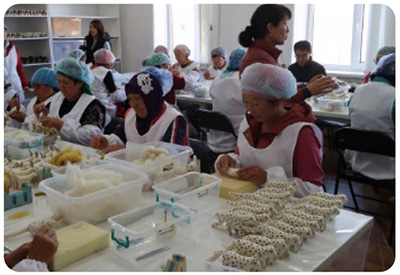Summary of the FY 2019 MOFA ODA Evaluations
Evaluation of Japan's ODA for Women's Empowerment (Summary)
Note: This summary was made by the ODA Evaluation Division base d on the report provided by the evaluation team.
The full text is available here:
| Evaluators (Evaluation Team) |
Chief Evaluator | Tatsufumi Yamagata Professor, College of Asia Pacific Studies, Ritsumeikan Asia Pacific University |
| Advisor | Yuriko Saito Researcher, International Peace Research Institute, Meiji Gakuin University |
|
| Consultant | Koei Research & Consulting Inc. | |
| Target Period | 2013–2018 | |
| Evaluation Period | Jul. 2019–Mar. 2020 | |
| Field Survey Country | The Republic of Kenya and the Kyrgyz Republic | |

Kyrgyz women making wool felt products at a factory
Background, Objectives and Scope of the Evaluation
Japan provides ODA with a commitment to promoting women's participation in every phase of development and ensuring equal benefit for men and women. The objectives of the evaluation are to obtain lessons and recommendations for formulating and implementing future ODA policies, and to enhance accountability through a comprehensive assessment of Japan's ODA and policies for gender equality and women's empowerment.
Brief Summary of Evaluation Results
● Development Viewpoints
(1) Relevance of Policies
Japan's gender ODA policy is consistent with its high-level ODA policies (e.g., the ODA Charter and the Development Cooperation Charter) as well as international assistance trends and the needs of partner countries. Given the implementation of many assistance programs for girls' education as well as disaster prevention programs that take into account women's needs and vulnerability, it can be said that Japan's gender ODA policy utilizes its experience and strengths. (Rating: Highly Satisfactory )
(2) Effectiveness of Results
Disbursements of gender-responsive projects and their proportion of disbursements in the total ODA amount increased. Japan has also achieved its pledged amount of assistance and number of beneficiaries between 2013 and 2018. Furthermore, Japan's contributions and achievements have been confirmed in the following three priority areas: (i) promoting women's and girls' rights; (ii) improving and enabling the environment for women and girls to reach their full potential; and (iii) advancing women's leadership in politics, economics and other public fields. (Rating: Highly Satisfactory )
(3) Appropriateness of Processes
The processes for formulating policies, implementing assistance, and promoting donor collaborations are appropriate. However, although the implementation status is monitored on a regular basis, the degree of achievement for policy objectives is not precisely measured due to a lack of action plans including specific indicators and deadlines. In terms of public relations, positive efforts have been seen both in Japan and abroad, but their effects have been found to be limited in Kenya and Kyrgyzstan, where the field studies were conducted. (Rating: Satisfactory )
Note: Ratings: Highly Satisfactory / Satisfactory / Partially Unsatisfactory / Unsatisfactory
● Diplomatic Viewpoints
(1) Diplomatic Importance
Gender equality and women's empowerment are indispensable for peace and stability in the international community and for achieving the SDGs. As the world pays great attention to gender equality, contributing to this sector using ODA, such as building a safe society for women and girls and contributing to women's access to social services and women's educational opportunities, is diplomatically important. Moreover, as it has been proved that the financial performance of companies that promote diversity is greater than those with less diversity, it can be said that empowering women in the workplace should create a favorable business environment for Japanese companies.
(2) Diplomatic Impact
Under pledges to support gender equality and women's empowerment in line with its national initiative to make Japan a country where women shine, Japan has remained committed to its contribution to its partner countries. Japan's commitment and collaborations with other donors have enhanced its presence in the international community. In terms of strengthening bilateral relations, for example, the regional development projects implemented in Kyrgyz have produced positive outcomes, such as creating jobs and improving the livelihoods of rural women. These outcomes have contributed to strengthening the bilateral relationship. It has also been confirmed that ODA provides opportunities for both partner countries and Japan to learn from each other. For example, training programs for African female entrepreneurs have also enhanced the capacity of Japanese female entrepreneurs through interaction opportunities.
Recommendations
(1) Create Gender Flagship Project
Japan should design a gender flagship project that represents Japan's ODA. Having a performance with high effectiveness and great impact would promote collaborations among Japan and other donors, which may lead to better partnerships and enhance Japan's ODA in the gender sector.
(2) Introduction of Results-based Management
Japan should apply a results-based management approach to its gender ODA policy. In order to regularly monitor and measure its progress, Japan should make action plans that include approaches to make sure of gendermainstreaming in every phase of development cooperation and also set deadlines. Japan needs to pledge not only the total ODA volume and the number of beneficial people, but also the share of ODA committed to gender equality.
(3) Expansion of Human/Financial Resources and Strengthening of ODA Systems
Additional human and financial resources need to be provided to strengthen ODA in the gender sector. MOFA and JICA should hire experts and/or train their employees to be experts in relation to country- and region-specific gender issues as well as issues such as human trafficking and genderbased violence. MOFA and JICA should also appropriately and effectively allocate human and financial resources.
